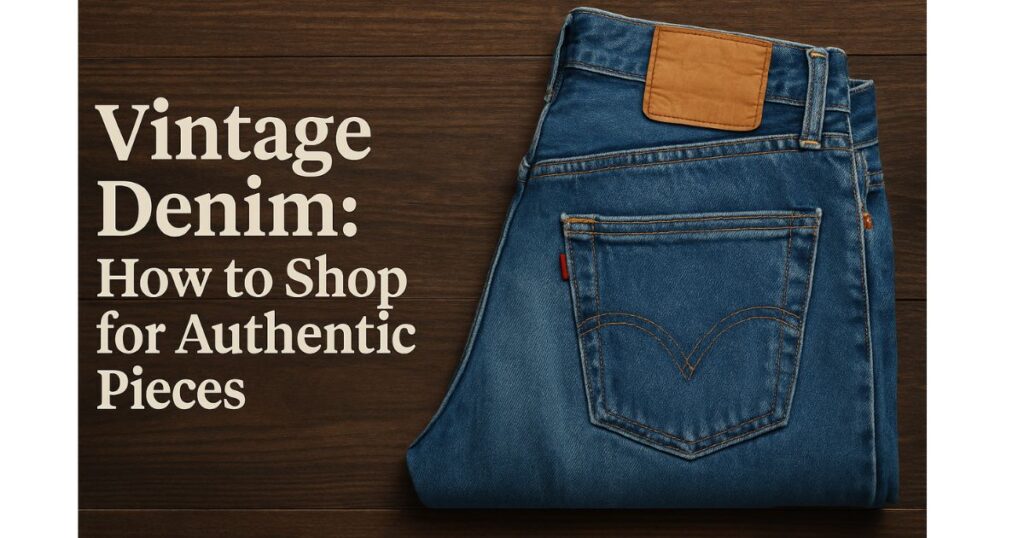Introduction
There’s something magical about slipping into a pair of vintage jeans. It’s not just the fit—it’s the history, the durability, the soul. In a world full of fast fashion and mass production, vintage denim stands tall like a rebel with a cause. Whether you’re a fashion junkie or just tired of buying the same cookie-cutter jeans, vintage denim offers a world of style, character, and conscious shopping.
Let’s break down exactly how you can hunt down authentic vintage denim like a pro.
Understanding Denim Eras
1950s–1960s: The Original Blue Collar Cool
This era gave us the blueprint of classic denim. Think heavyweight, raw denim with a rigid texture. Levi’s ruled the scene with their Big “E” red tab, hidden rivets, and button fly 501s.
Look for:
-
High waist
-
Straight-leg fit
-
Selvedge seams
-
Made in USA tags
1970s: Groove and Flare
The ‘70s brought in funky fashion—flared jeans, bell-bottoms, patchwork, and wild embroidery. Denim got bolder, and branding became more creative.
Clues it’s from this era:
-
Colorful stitching
-
Mid-rise cuts
-
Bold font labels with psychedelic influence
1980s–1990s: Logo Mania & Grunge Vibes
Denim got experimental. You’ll see acid wash, stonewashed finishes, oversized fits, and loud logos.
Key signs:
-
Branded back patches (Guess, CK, Wrangler)
-
High taper or loose “dad jean” styles
-
Thin denim with light fading
How to Identify Authentic Vintage Denim
Labels and Tags
Start with the tag. Levi’s “Big E” (capital “E” in LEVI’S) stopped around 1971. Union tags or factory numbers like “555” hint at vintage credibility. If it says Made in USA, that’s a green flag.
Hardware and Seams
Genuine vintage jeans have:
-
Copper rivets (often tarnished with age)
-
Donut buttons
-
Selvedge edges (a clean finish on the outseam)
-
Zippers by brands like Talon, Lightning, or YKK
Feel the Fabric
Vintage denim isn’t soft and stretchy. It’s thick, a bit coarse, and shows natural fading in the knees and thighs. Artificial distressing has a pattern—authentic wear looks random and earned.
Where to Score Real Vintage Jeans
Thrift Stores & Flea Markets
These are gold mines if you’ve got patience. Dig through piles, feel the fabric, and don’t obsess over brand names.
Online Marketplaces
Sites like Etsy, eBay, and Depop offer a huge selection. Use filters, ask sellers for close-ups of tags and seams, and always check measurements.
Vintage Boutiques
More expensive, but many do the legwork of verifying authenticity. Great if you’re new to vintage shopping and want a curated pick.
Vintage Denim Fit & Sizing Guide
Vintage sizes are not like today’s. A size 32 from the ‘70s might fit like a 29-30 now.
Tips:
-
Measure your best-fitting jeans and compare
-
Pay attention to rise and inseam
-
Don’t rely on label size—trust the tape measure
Condition Counts
Not all “vintage” jeans are worth buying.
Watch for:
-
Heavy staining or mildew smells
-
Moth holes or weak seams
-
Broken zippers (unless you’re into repairs)
It’s okay to accept minor frays or faded knees—they add charm. But big structural issues? Pass.
How to Care for Vintage Denim
You scored the perfect pair—now don’t ruin them!
Washing tips:
-
Cold water only
-
Wash inside-out
-
Avoid bleach or heavy detergents
Drying:
-
Air dry only—no dryers!
Repairs:
Use visible mending techniques like sashiko, or take them to a denim repair specialist for pro-level fixes.
Why Vintage Denim Is a Sustainable Choice
Fast fashion’s dirty secret? Waste, pollution, and low-quality goods. Buying vintage fights back by recycling style and reducing demand for new resources.
You:
-
Lower your carbon footprint
-
Support circular fashion
-
Get long-lasting jeans with history
Styling Vintage Denim
Modern Meets Retro
Pair vintage jeans with:
-
A white tee and leather jacket (classic)
-
Cropped hoodie and sneakers (modern twist)
Statement or Chill?
Distressed denim = bold.
Dark wash = versatile.
Oversized = comfy cool.
Play with proportions and textures. Mix vintage with modern to keep it fresh.
Common Mistakes When Shopping Vintage
-
Skipping Measurements: Always compare actual inches, not labels.
-
Ignoring Wear and Tear: Some flaws are fine—others aren’t.
-
Overpaying for Common Brands: Not all Levi’s are rare. Know what you’re buying.
Top Brands to Look Out For
Some brands are vintage royalty:
-
Levi’s (501s, 505s, 517s)
-
Wrangler
-
Lee
-
Calvin Klein
-
Guess (especially 90s era)
Rare models and limited editions hold high value for collectors.
Rarity and Value: What Makes a Pair Worth It?
True vintage gems include:
-
Deadstock: New but decades old
-
Limited runs or rare factory codes
-
Styles discontinued long ago
The rarer the details, the more valuable. Know your stuff before splurging!
Shopping Tips from Vintage Collectors
-
Check inside pocket bags—some have dates stamped.
-
Carry a measuring tape with you.
-
Trust your fingers: vintage feels thicker and more rigid.
Conclusion
Vintage denim isn’t just something you wear—it’s something you discover. Each pair tells a story, and finding the perfect one takes time, patience, and a bit of denim detective work. From spotting a Big “E” to rocking a pair of 90s stonewashed jeans, the thrill is real. So dive in, get your hands dirty, and start hunting!
FAQs
1. How can I tell if denim is vintage?
Check for era-specific tags, selvedge seams, Big “E” branding, and authentic hardware like Talon zippers or copper rivets.
2. Is vintage denim better quality?
Yes! Older denim was often woven from thicker, more durable cotton and crafted to last decades.
3. Are vintage jeans more expensive?
Not always. Thrift finds can be cheap, but rare pieces from sought-after brands can command high prices.
4. Can you tailor vintage denim?
Yes, but avoid altering the waist—this can lower its value. Hemming or tapering is usually fine.
5. What is deadstock denim?
Deadstock refers to unworn, original vintage denim that was never sold or worn—basically, new old stock.

